| David Junchen called it one of the finest three or four theatre organs extant, and one of the most famous organs in history. Its résumé includes two trips across the Atlantic, installations in three different countries, and recordings by some of the world’s greatest organists. As the BBC broadcasting organ, it lifted the morale for all of Great Britain during World War II, and then performed for pizza patrons in America during the 1970s. The story of the instrument is so intriguing that it has graced the pages of the THEATRE ORGAN JOURNAL many times. |
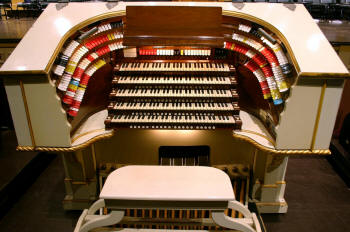 |
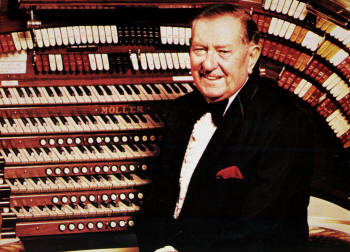 |
In 1938, at the height of his popularity as the BBC staff organist, Reginald Foort resigned his post to travel the vaudeville circuit in Great Britain—with a pipe organ. And while a modest instrument would have been the most practical, Foort didn’t have practical in mind. He wanted to make sure the audience saw and heard a “mighty” theatre organ. He didn’t want the audience to say, “Well, it’s a nice organ but they have a far bigger and better one up the street at the Paramount Theatre.” His final design had 5 manuals and 27 ranks—ranking it as one of the largest theatre instruments ever built. Finding a theatre organ builder in 1938 to undertake such an instrument was no small task. |
| Foort first approached English organ builders with his idea, but was met with attempts to change and downsize the instrument. Turning to America, Möller was the logical (and perhaps only) choice. The Robert-Morton firm effectively ended business in 1933, Barton in 1931, and Kimball hadn’t made a theatre organ since 1930. Wurlitzer was still shipping organs to England as late as 1939 but the cost would have been, undoubtedly, prohibitive. |
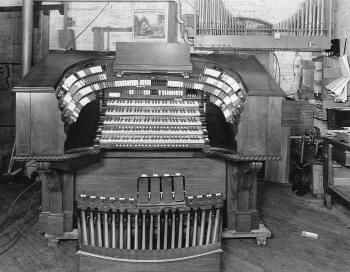 |
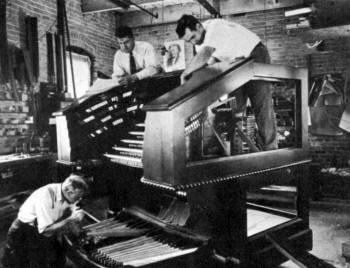 |
Möller Builds a Legend
The Möller instrument was a marvel in many aspects. Weighing in at 30 tons, the “portable” organ had its 27 ranks distributed on nine steel frames, each self-contained with its own windchests, regulators, and tremulants. The frames were on giant casters which allowed them to be rolled on and off the four large trucks that made up the Foort caravan. They had to travel with six different blower motors—to account for the different electrical systems throughout Great Britain. |
| With a staff of fifteen that included four truck drivers (who rapidly became organ experts), three organ builders, two electricians, and two stage riggers, they could normally take the organ down and load it onto the trucks in about 4½ hours. Set-up took longer, roughly 16 hours, but that accounted for any necessary adjustments and tuning. According to Foort, very little tuning was required: “Apart from an occasional slipped stopper in a tibia pipe, the flue stops stayed mostly dead in tune, and Möller had fitted the tuning wire of every reed pipe with a set screw which prevented the reed from getting bumped out of tune over rough roads.” |
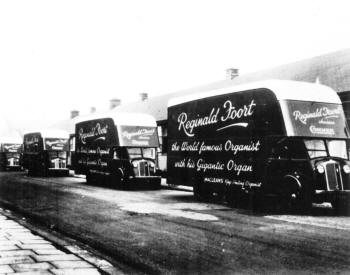 |
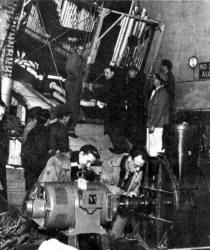 |
The moves were not entirely without mishap. If the audience noticed the lack of trumpet on the second visit to the Hippodrome Theatre in Birmingham, there was an explanation. When unloading this section, a rope had broken and the entire unit crashed into a wall, snapping off the resonators on 28 trumpet pipes. The organ also had some close calls when World War II began. During a week’s engagement at the Empire Theatre in Liverpool, bombs were dropping all around the theatre. At the Saturday evening performance, these explosions caused three fires in the theatre roof space, which were put out by the organ crew while the show continued. |
| Normally the instrument sat on the stage with only a wall of shutters in front of the pipes. These were usually suspended or “flown” on a pipe from the stage fly system. At the very end of the finale, this “wall” was lifted out of sight and the thunderous sound of the organ literally brought the house down. |
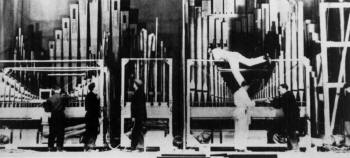 |
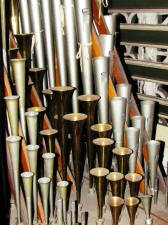 |
The organ had three Tibias, patterned after New York Paramount 4/36 Fox special. Foort had played at the Paramount for an extended engagement in 1935 and the sound of the Paramount Tibias had stuck in his mind. The organ had five 16' stops, including Tuba, Trumpet, Diaphone, Bourdon, and Gamba. The 16' Gamba pipes were soon deemed too fragile for traveling, and they remained in storage until the organ was permanently installed. The organ contains one of the largest Tibias ever constructed (Tibia Clausa I), so big that it wouldn’t fit on the voicing machine at the factory! It also has the only Brass Trumpet manufactured by the company. |
Möller Becomes Voice of the BBC
As the war progressed, it became more difficult to tour. The theatres were closed for a time by the government, and the R.A.F. commandeered two of the trucks right away. Foort cut the organ down by one third so they could continue touring by train, but the constant bombing made any travel difficult. The BBC studio, with its 4/24 Compton organ, had been destroyed in the first air raid on London. The news was not made public, but when Foort and his crew noticed that radio broadcasts were being done on a Hammond organ, he inquired about the situation. On hearing the news, he promptly offered his Möller to the BBC for the duration. The BBC accepted the offer, and the organ was installed in a theatre in North Wales. It was moved to another theatre before the war was over, but was heard regularly by (probably) every British citizen and soldier during the war. |
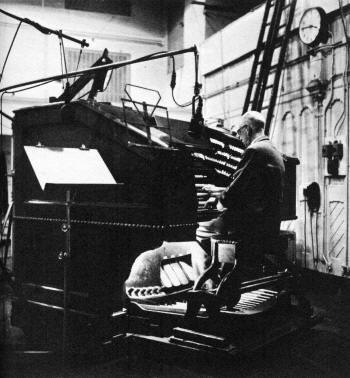 |
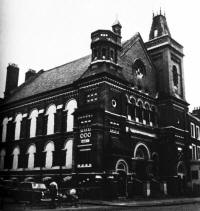 |
By the end of the war, Foort realized touring again was out of the question. Many theatres had been damaged or destroyed, and vaudeville was clearly on the way out. He made a deal to sell the organ to the BBC, which acquired a church in London for a new broadcasting studio. The organ was installed in the “Jubilee Chapel” and remained there for almost 30 years, being broadcast and recorded by some of the greatest organists in history. This could conclude a fascinating history of any instrument, but the story continues.... |
Broadcasting in the Netherlands
By 1963, the BBC was done broadcasting theatre organ, and the instrument was sold to Dutch Radio Hilversum. Over the course of two years, the Möller was installed in a church in Hilversum, Netherlands. The organist, Cor Steyn, was largely responsible for its installation, but he passed away soon after it went on the air. With a lack of suitable players, the instrument remained silent throughout most of its stay in Holland. In the summer of 1973, Peter Daniels of the Möller Company traveled to Hilversum to make a detailed inspection of the organ for a prospective buyer. Upon his return and detailed report, Paul Kreglo, Möller factory superintendent, made a trip to Holland to supervise the removal, packing, and shipping of the instrument back to the Möller factory. Preston M. (Sandy) Fleet had purchased it for a southern California pizza parlor. |
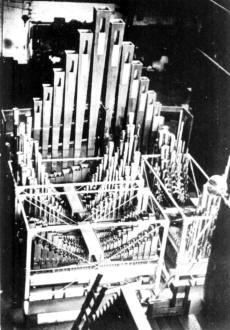 |
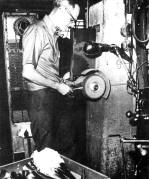 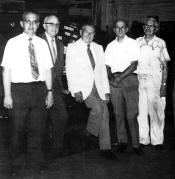 |
Opus 6690 Reborn
Thirty-five years after it left the factory, the Möller returned for a complete refurbishing. Every chest was renewed, every pipe cleaned, and the entire console was taken apart for rebuilding, then refinished in white and gold. The Doppel Flute was replaced with a Brass Saxophone, while the original Saxophone was replaced by a French Horn. The Post Horn rank was given a new 16' extension. While working, factory employees would listen to reel-to-reel recordings of Foort performing on the instrument. |
| After its stay at the factory, it was installed in Organ Power Pizza #2 in Pacific Beach, California, slightly north of San Diego. In November 1975, Foort sat down to dedicate the organ again—this time to an American audience. Organ Power Pizza flourished for a time (as pizza parlors do) with an outstanding staff of organists including Chris Gorsuch, Cheryl and Wayne Seppala, and Tommy Stark. Several recordings were made on the instrument in its new home, but by 1979 it was for sale again. |
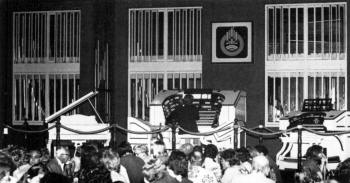 |
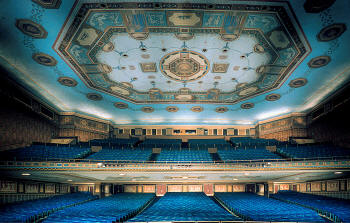 |
Pasadena Civic Auditorium
Opening in 1932 in the midst of the depression, it missed the city-owned municipal-organ mentality by more than a decade. But the grillwork was there, and there was chamber space backstage, even if it was taller than wide. Built in an Italian Renaissance Revival style, the auditorium can seat 3029. A favorite of Hollywood producers because of its wide house, sweeping sightlines, and easy load-in, it has served as the home of the Prime Time Emmy Awards, the People’s Choice Awards, and many other broadcast events. |
| When the Foort Möller became available, Gordon Belt and J.B Nethercutt formulated a plan to purchase the organ and donate it the city of Pasadena for installation in the auditorium. In January 1979, the city council accepted the organ. The resolution closed with: “On behalf of the citizens of Pasadena, this board expresses its deep appreciation to Mr. Nethercutt for donating this most valuable and unique instrument to the City of Pasadena for use in the Pasadena Civic Auditorium for the enjoyment of all." On April 23, 1980, Tom Hazleton presented the dedication concert. Reginald Foort was in attendance, and was moved to tears. Dave Junchen and Steve Adams had spent nine months installing the instrument and coaxing a more theatrical sound from its Möller pipework and tremulants. Most agree the result is spectacular. |
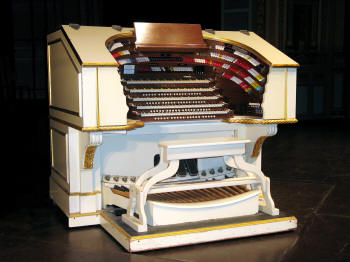 |
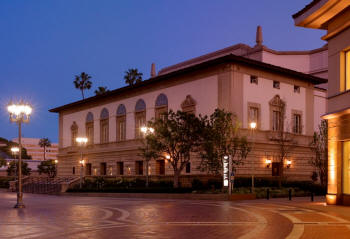 |
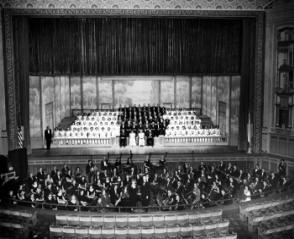 |
| |
Don Feely, Website Editor
|